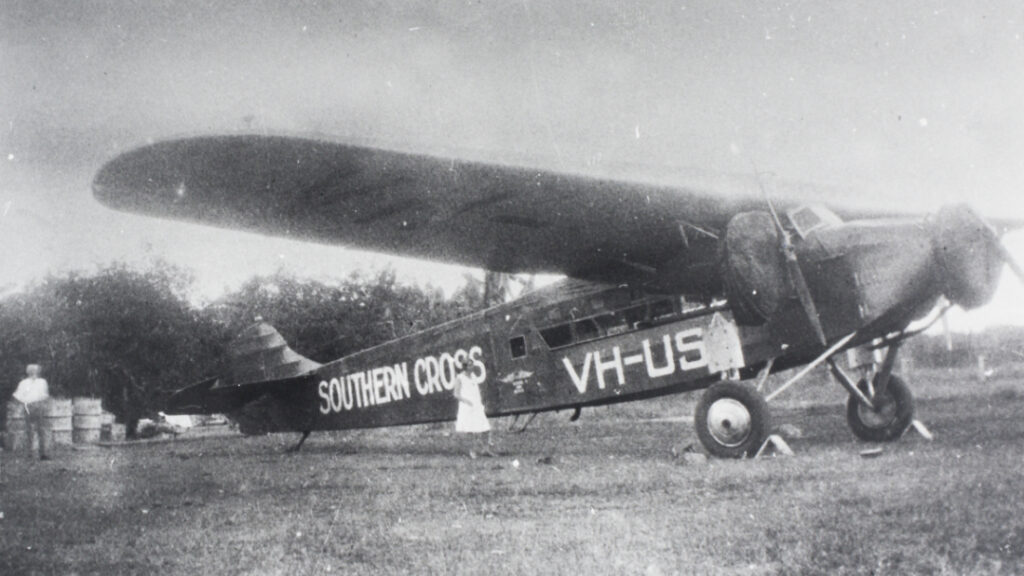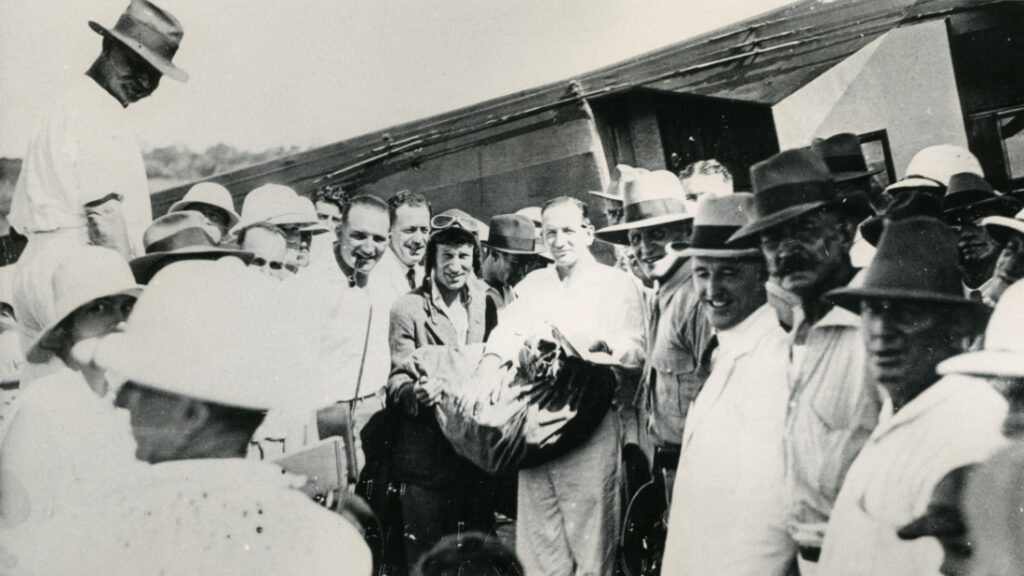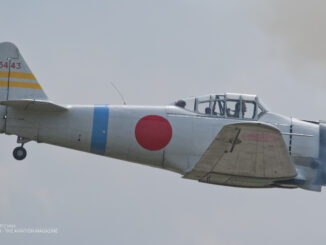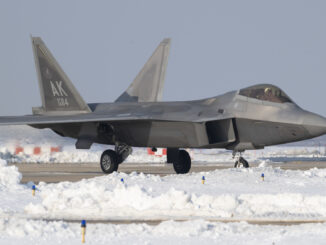 On 9th June 1928, a Fokker F.VII/3 named ´Southern Cross´ flown by Charles Kingsford Smith and his crew, successfully landed in Brisbane, Australia, therefore completing the 11,566-kilometre-long journey from Oakland, California.
On 9th June 1928, a Fokker F.VII/3 named ´Southern Cross´ flown by Charles Kingsford Smith and his crew, successfully landed in Brisbane, Australia, therefore completing the 11,566-kilometre-long journey from Oakland, California.
Sir Charles Edward Kingsford Smith was born on 9th February 1897 in Brisbane, Australia. During the Great War, he enlisted the Australian Army where he became a motorcycle dispatch rider and participated in the Gallipoli campaign. In 1917, Kingsford Smith was transferred to the Royal Flying Corps, earned his pilot license and then served in No. 23 Squadron.
After the war, Kingsford Smith was taking various jobs as a pilot. He offered sightseeing flights in England, performed aviation stunts in the United States, and also he flew as a commercial pilot. Finally, Kingsford Smith joined the newly established West Australian Airways and became one of the pioneering Australian airline pilots. And it was exactly the time when he began to think about the transpacific flight.
In the late 1920s, the Pacific Ocean was still unconquered by an aircraft. Although the first transatlantic flight was successfully performed as early as in 1919 – lasting an incredible twenty-three days with six stops along the way – the estimated distance of a transpacific flight made it significantly more challenging.
The first attempt for crossing the Pacific Ocean was made in 1927 by Ernie Smith and Emory Bronte. They flew from Oakland, California in a Travel Air aeroplane, making it successfully to Molokai Island in Hawaii archipelago – where they crash-landed due to running out of fuel.
One year later, Charles Kingsford Smith and his co-pilot, Charles Ulm, decided to cross the Pacific Ocean in the Fokker F.VII/3 aeroplane they bought from Sir Hubert Wilkins, the Australian polar explorer. They called the aircraft ´Southern Cross´ and planned a transpacific route from Oakland to Brisbane.
On 31st May 1928, Kingsford Smith, Ulm and two more crew members – navigator Harry Lyon and radio operator James Warner – took-off from Oakland and headed Hawaii archipelago. Their first stopover took place at Wheeler Army Airfield, O´ahu island, 3,870 kilometres from California. The flight to Hawaii lasted 27 hours and 25 minutes.

The next stage of their journey was more than five-thousand-kilometre route to Fiji. On 6th June, Kingsford Smith and his crew landed at Albert Park in Suva, welcomed by an enthusiastic crowd. Not surprisingly, as the ´Southern Cross´ was the first aircraft ever to land at Fiji.
The final stage of the flight was also the shortest one, covering only 2,700 kilometres. The Southern Cross took-off from Fiji and after twenty hours of flight the aircraft reached Australian coast near Ballina. Shortly after, at 10:50 hours on 9th June, Kingsford Smith and his crew landed in Brisbane, met by a crowd of more than 25,000 people. The first, 11,566-kilometre-long, transpacific flight was successfully completed.
Almost immediately, Charles Kingsford Smith was treated as an Australian national hero. His flight inspired many young people to become aviators, including Jean Batten. Two years after attending a meeting with Kingsford Smith, the New Zealander went to England and learned to fly there. In a few years, she became the worldwide-known, record-breaking aviatrix.
Crossing the Pacific Ocean was the first of long-distance flights performed by Kingsford Smith and Ulm. In August of 1928, they made the first non-stop flight across Australia, flying from Melbourne to Perth. In September of the same year, they successfully completed the first non-stop Trans-Tasman flight, from Australia to New Zealand on a distance of 2,670 kilometres. Both flights were performed in the same ´Southern Cross´ trimotor aircraft they used for the transpacific flight.
In 1929, the aircraft made another long journey, this time to the Netherlands, where it was overhauled in Fokker company. Then, in June of 1930, Kingston Smith flew the Southern Cross from Ireland to Newfoundland in a westbound transatlantic flight. And next, he flew across the United States to Oakland, therefore completing a circumnavigation flight with the Southern Cross he started in 1928. It should be noted that at every stopover, Kingston Smith and his aircraft were welcomed by a big crowd of aviation enthusiasts.

The Southern Cross returned to Australia on 22nd October 1930. During the return flight, Kingston Smith took part in England-to-Australia air race and won that event.
In 1935, Kingston Smith sold the Southern Cross to the Commonwealth of Australia for 3,000 GBP. The aircraft was restored and today is exhibited in a purpose-built memorial at Brisbane Airport.
Two other aircraft Kingston Smith bought in the early 1930s were named with reference to his famous aeroplane. It was an Avro Avian known as the Southern Cross Minor and a Lockheed Altair named the Lady Southern Cross.
In November of 1935, Kingsford Smith and John Thompson Pethybridge as his co-pilot, made an attempt to break the speed record of England-to-Australia route, flying the Lady Southern Cross. On 8th November, the crew and the aircraft disappeared over the Andaman Sea.
In 1937, an undercarriage leg and wheel of the Lady Southern Cross was found by Burmese fishermen. Neither bodies of her crew were recovered, nor the rest of aircraft found – despite the latest claims that finally were left without any proof.
Charles Kingsford Smith was commemorated by two documentaries made in the 1930s, as well as an Australian film ´Smithy´ made in 1946 and television series from 1985. What´s more, several books were written to describe his life and aviation achievements.
The major airport of Sydney was named Kingsford Smith International Airport in his honour. Both Quantas and KLM named one of their aircraft after the Australian aviation pioneer. He was also honoured in Fiji – Albert Park in Suva, where the Southern Cross landed in 1928, currently includes the Kingsford Smith Pavilion.

Cover photo: Fokker F.VIIb/3m VH-USU ‘Southern Cross’ in Darwin, 1930 / Library & Archives NT, Irene Annie Bull Collection, PH1168/0014, Public Domain



